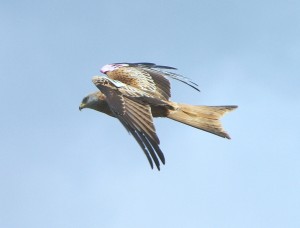For more than 20 years scientists have known that a swarm of killer bees has been heading for the United States. Now Warner Brothers presents Irwin Allen’s The Swarm
Its size is immeasurable, its power is limitless, its enemy is man!
It is more than speculation, it is prediction!
The Swarm, theatrical trailer
As preparation for last week’s lecture on the honey bee I re-watched Irwin Allen’s 1978 disaster movie The Swarm. This film was fuelled by the growing hysteria in the US at the time over the imminent arrival of the ‘killer bee’, better called the Africanised bee, the result of accidentally releasing a southern African strain of the honey bee Apis mellifera imported into Brazil in 1956, with the aim of improving honey production compared to the European races used previously. Unfortunately the new strain was not a good honey producer, but was rather aggressive, having a much shorter temper than most European strains and thus quick to swarm and carry out a mass attack. This resulted in hundreds of fatalities in South America, until humans learnt to cope with this new bee. And this is the premise of this film, that the killer bee (still in 1978 restricted to South America) has come directly into Texas from Venezuela, and spreads, causing havoc, culminating in the almost destruction of Houston.
The film is interminably long (149 minutes on the DVD version), and with generally poor and very cheap special effects, truly awful dialogue and wooden acting (the normally charitable Radio Times Film Guide says ‘hive of Hollywood has-beens try to out-ham each other while reciting terrible dialogue’) it is no wonder that it failed spectacularly – it took only $10 million at the box office, whilst costing $21 million to make – most probably spent on the salaries of a plethora of stars that appeared. Michael Caine (who plays an entomologist, ha!) said it was his worst film (and some would say that there is some competition for that title), and Irwin Allen refused to talk about the film after release. Yet, it is probably the best of the killer bee films, several of which appeared subsequently and often were not even about killer bees (wasps were a favourite).
The film is a curious mixture of almost-correct science and downright misinformation, some of which is repeated by the actors and production staff in the ‘making of’ documentary Inside the Swarm, which also appears on the DVD.
On the almost-correct side, at least for some of the special effects they used real honey bees, 20 million of them, quite a few of which they de-stinged (is it the only film to list in the credits two ‘Bee Technical Advisors’?), and the overall premise of the film was true (something that several reviewers seem to have missed). Also the film correctly discusses problems inherent in trying to control such an invader – if you spray insecticide over a wide area you will also kill all the beneficial insect pollinators, and probably make the situation even worse. Yet, it is just as well that few saw the film, as if the exaggerated aspects were taken as truth then viewers could have been truly terrified. For example:
1. Huge swarms of killer bees are shown, blotting out the light and downing aircraft. Honey Bees are not locusts (don’t get me started on locust films), they don’t produce large swarms. A European honey bee swarm may have 20,000 workers, and Africanised honey bees produce smaller colonies and swarms than this. Enough to terrify a picnic, hardly enough to worry to a city.
2. Our entomologist Michael Caine repeatedly says that these killer bees are mutants. Not so.
3. He continues to say that their venom is far more potent than ‘normal’ honey bees, with only four stings killing (before which you hallucinate, seeing a huge bee coming for you) a human. Again, not so, the sting from a killer bee is reputedly no or little worse than one from another honey bee, it is the numbers of stings inflicted which can kill.
4. No dead bees are seen. After the first attack, at a US missile base, many service personnel are killed, yet the investigators cannot find the cause. As bees die after stinging, there should be a number of dead bees around.
One can also enjoy the dialogue, often between the dream team of Michael Caine’s entomologist and Henry Fonda’s immunologist. Here is just a taste:
‘Who’d have thought that bees would be the first alien force to invade America?’
‘We’ve been fighting a losing battle against the insects for 15 years but I never thought I’d see the final face-off in my lifetime, and I never dreamed that it would turn out to be the bees, they’ve always been our friends’
Caine: ‘They’re brighter than we thought’, Fonda: ‘They always are’
The film ends with a disclaimer:
‘The African killer bee portrayed in this film bears absolutely no relationship to the industrious, hard-working American Honey Bee to which we are indebted for pollinating vital crops that feed our nation’
That’s all right then: don’t go getting upset now, all you industrious American Honey Bees, we love you really!
If you have not lost the will by the end of this film you start to wonder whether it is really a spoof disaster movie; if so no one has admitted to it. There are rumours that this film is being re-made. Will it also include varroa and colony collapse disorder, or perhaps it will tell the story of the hunt for all the bees abducted by mobile phone wielding aliens? Truly, the mind boggles.

